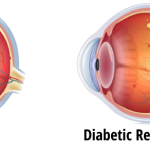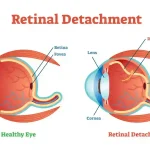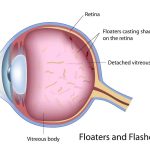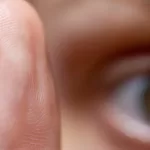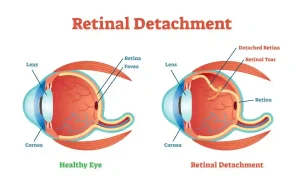
Retinal Detachment: Causes, Symptoms, Care, Remedies, and Treatment
Introduction
Retinal detachment is a serious eye condition that occurs when the retina, the thin layer of tissue at the back of the eye, pulls away from its normal position. If left untreated, it can lead to permanent vision loss. Understanding the causes, symptoms, care, and treatment options is crucial for timely intervention and prevention of severe complications.
Understanding the Retina
The retina is a light-sensitive layer of tissue responsible for capturing images and sending signals to the brain via the optic nerve. When it detaches from the underlying layers of the eye, it loses its ability to function properly, leading to partial or complete vision loss.
Causes of Retinal Detachment
There are three primary types of retinal detachment, each caused by different factors:
- Rhegmatogenous Retinal Detachment:
- Caused by a tear or hole in the retina that allows fluid to seep underneath and separate it from the underlying tissue.
- Common risk factors include aging, severe nearsightedness (myopia), eye trauma, or previous eye surgery.
- Tractional Retinal Detachment:
- Occurs when scar tissue on the retina contracts and pulls it away from the back of the eye.
- Often seen in people with diabetes-related eye diseases, such as diabetic retinopathy.
- Exudative (Serous) Retinal Detachment:
- Results from fluid accumulation under the retina without any tears or holes.
- Can be caused by inflammatory diseases, tumors, or age-related macular degeneration.
Symptoms of Retinal Detachment
Retinal detachment is usually painless, but the symptoms can be alarming. Warning signs include:
- Sudden appearance of floaters (tiny specks or cobweb-like shapes drifting in vision)
- Flashes of light in one or both eyes
- Blurred vision or a sudden decrease in vision
- A shadow or curtain effect over part of the visual field
- Loss of peripheral (side) vision
Emergency Care and First Response
Retinal detachment is a medical emergency that requires immediate attention. If you experience any of the symptoms mentioned above, follow these steps:
- Seek Medical Help: Visit an ophthalmologist or emergency eye clinic without delay.
- Avoid Sudden Head Movements: Keep your head stable to prevent further detachment.
- Avoid Strenuous Activities: Do not engage in heavy lifting or physical exertion until assessed by a doctor.
Diagnosis of Retinal Detachment
An eye specialist will perform the following tests to diagnose retinal detachment:
- Dilated Eye Exam: Uses special eye drops to widen the pupil and examine the retina with a bright light.
- Ultrasound Imaging: If the retina cannot be clearly seen, ultrasound helps detect detachment.
- Optical Coherence Tomography (OCT): Provides a detailed cross-sectional image of the retina.
Treatment Options
Treatment for retinal detachment depends on its severity and cause. Some of the most common procedures include:
1. Laser Surgery (Photocoagulation)
- Uses a laser to seal a retinal tear before it leads to detachment.
- Effective for small or early-stage tears.
2. Cryopexy (Freezing Treatment)
- Involves freezing the area around a retinal tear to create scar tissue that helps reattach the retina.
- Often used in conjunction with other treatments.
3. Pneumatic Retinopexy
- A gas bubble is injected into the eye to push the detached retina back into place.
- The patient must maintain a specific head position to keep the bubble in place while the retina heals.
4. Scleral Buckling Surgery
- A silicone band is placed around the eye to gently push the detached retina back.
- Often used for more severe cases of detachment.
5. Vitrectomy
- A surgical procedure that removes the vitreous gel from the eye and replaces it with gas, air, or silicone oil to help the retina reattach.
- Used for complex cases, such as tractional detachment or severe retinal tears.
Post-Treatment Care and Recovery
After undergoing retinal detachment treatment, proper care is crucial for recovery:
- Follow your doctor’s instructions carefully.
- Avoid strenuous activities that may put pressure on the eyes.
- Use prescribed eye drops to prevent infection and inflammation.
- Maintain proper head positioning (if a gas bubble was used) to facilitate healing.
- Attend follow-up appointments to monitor healing and ensure the retina stays attached.
Preventive Measures and Remedies
While not all cases of retinal detachment can be prevented, certain lifestyle choices can reduce the risk:
- Regular Eye Check-ups: Early detection of retinal tears can prevent detachment.
- Manage Underlying Health Conditions: Control diabetes and high blood pressure to reduce eye complications.
- Protect Your Eyes from Trauma: Wear protective eyewear during sports or risky activities.
- Avoid Sudden Head Movements: Particularly if you have a high risk of retinal detachment.
- Be Aware of Symptoms: Recognizing early signs can lead to timely medical intervention.
Conclusion
Retinal detachment is a serious condition that requires immediate medical attention. Understanding its causes, symptoms, and treatment options can help individuals take proactive steps to protect their vision. Regular eye check-ups, maintaining a healthy lifestyle, and seeking timely medical care can significantly improve the chances of preserving sight and preventing complications.

